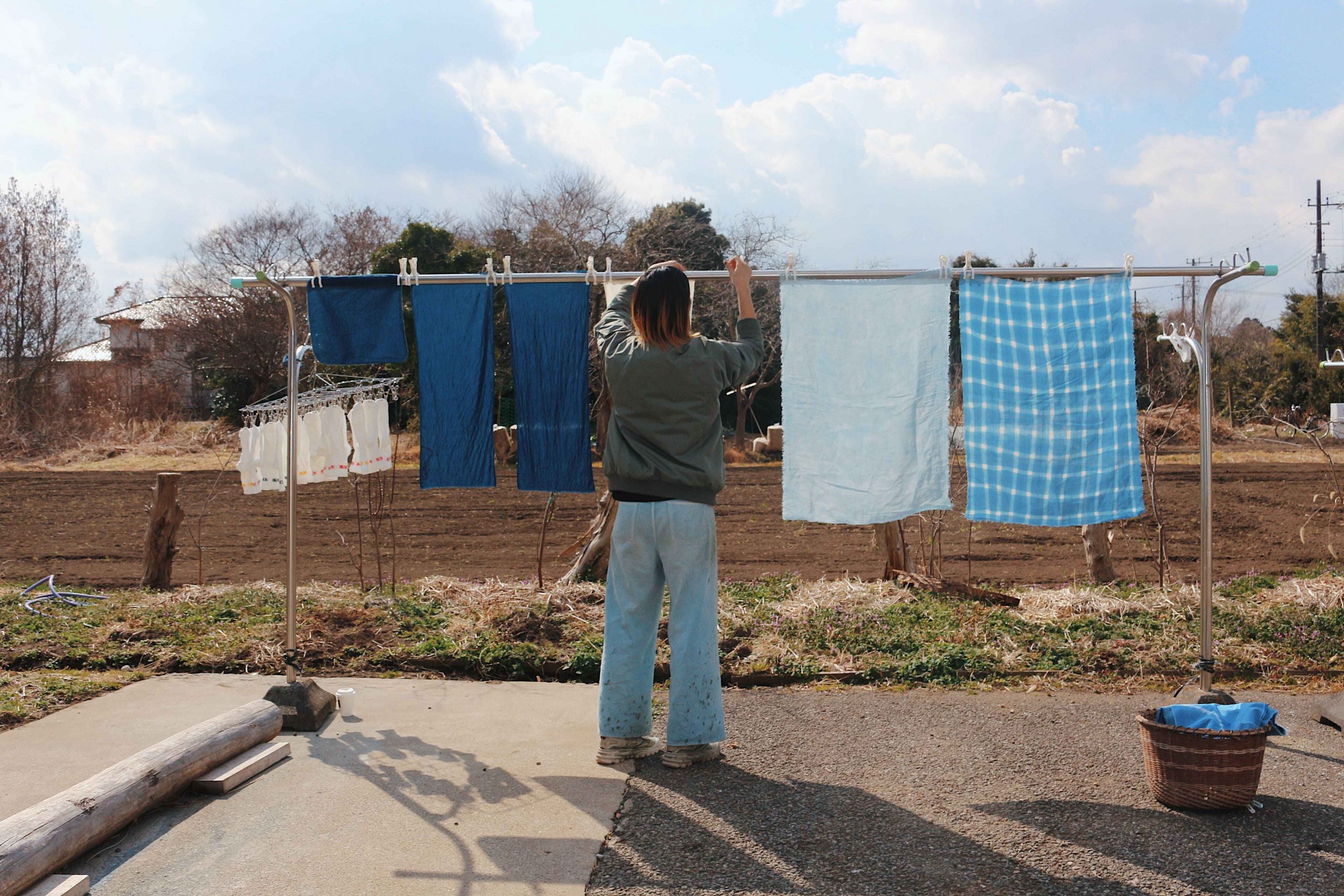
2025年の新作柄を手がけてくださったのは、千葉県九十九里にある藍染工房〈NORABI〉の品田彩来さん。かつて女子サッカー選手として世界を巡った彩来さんは、引退後、環境問題への関心をきっかけに藍染の世界へと歩みを進めました。
彼女とeit swimチームが出会ったのは、工房を立ち上げたばかりの頃。ご近所だったこともあり、前を通るたびに物干し竿に揺れる藍色の布が目に入り、心がわくわくしたのを覚えています。
今回のインタビューでは、藍染との出会い、環境への想い、そして制作していただいた柄についてお話を伺いました。
For our 2025 collection, we had the honor of collaborating with Ayaka Shinada from NORABI, an indigo dye studio based in Kujūkuri, Chiba. Ayaka’s journey into the world of traditional Japanese indigo dyeing began after retiring from her career as a professional soccer player. Motivated by a deep concern for the environment, she found herself drawn to this ancient, sustainable craft.
We first met Ayaka shortly after she launched her studio. At the time, she was still new to the neighborhood—but every time we passed by, we couldn’t help but feel a quiet thrill at the sight of indigo-dyed fabrics swaying on her drying racks.
In this interview, Ayaka shares how she discovered indigo dyeing, her thoughts on sustainability, and the inspiration behind the beautiful patterns she created for eit swim.
── 藍染を始めたきっかけを教えてください。
サッカーを辞めた理由は、気候変動に関わる活動をしたいという想いがあったからです。ただ、ただ、引退後に改めて環境問題について勉強し直したとき、自分なりに学んでいたつもりでしたが、実際はまだまだ知らないことばかりでした。きっと、一般的にも知られていないことが多いのではないかと思ったんです。 その上で、これから関わっていきたいこと、自分ができることを書き出し、世界の流れも整理していくなかで、生物学、アート、アパレル、農業、繊維、薬効など、自分の関心があるものが藍染には含まれていることに気がつきました。歴史が深いことも知り、少しやってみよう、もっと知ってみたいという想いから学び始めました。化学結合によって青く発色することや、原料が循環に適していることにも大きな魅力を感じました。
── サッカー選手時代に、どのように環境問題への関心が芽生えたのでしょうか?
もともと両親が環境への関心が強く、日常の中でもそういった話題に触れる機会が多くありました。兄は文化人類学の学者でありながら映像作家でもあり、アマゾンの熱帯雨林に1年間滞在してリサーチを行い、ドキュメンタリーを制作したこともあります。そんな背景からアマゾンでの森林火災の問題を目にすることもあって。特に2019年ごろから、地球全体が一段階別のフェーズに入ったような感覚がありました。
プロサッカーには資本主義的な構造があって、女子サッカーも徐々にそういう方向に向かっているような感覚がありました。好きだったから、夢だったからという理由だけでは続けられないと思うようになったんです。
── What inspired you to start working with indigo?
I stepped away from soccer because I wanted to dedicate myself to work related to climate change. After retiring, I went back to study environmental issues in more depth. I realized that even though I thought I was somewhat informed, there was still so much I didn’t know—and I felt that was likely true for many people.
As I started mapping out the things I wanted to do and areas I cared about—biology, art, fashion, agriculture, textiles, even medicinal plants—I realized indigo dyeing touched on all of them. The craft has deep historical roots, uses natural materials that fit well within a circular system, and the chemistry of how it turns blue fascinated me. That’s when I decided to dive in.
── Did your interest in the environment begin during your soccer career?
In a way, yes. My parents have always been passionate about environmental issues, so it was something I grew up with. My brother is a cultural anthropologist and filmmaker—he once spent a year in the Amazon rainforest doing field research and made a documentary about it. That gave me a direct view of the environmental devastation happening there, especially the fires. Around 2019, I felt like the planet had entered a new, more urgent phase.
At the same time, I was noticing how even women’s soccer, which had always felt somewhat outside of the capitalist machine, was becoming increasingly commercial. I loved the sport, but I started to feel like that wasn’t enough to keep me going.
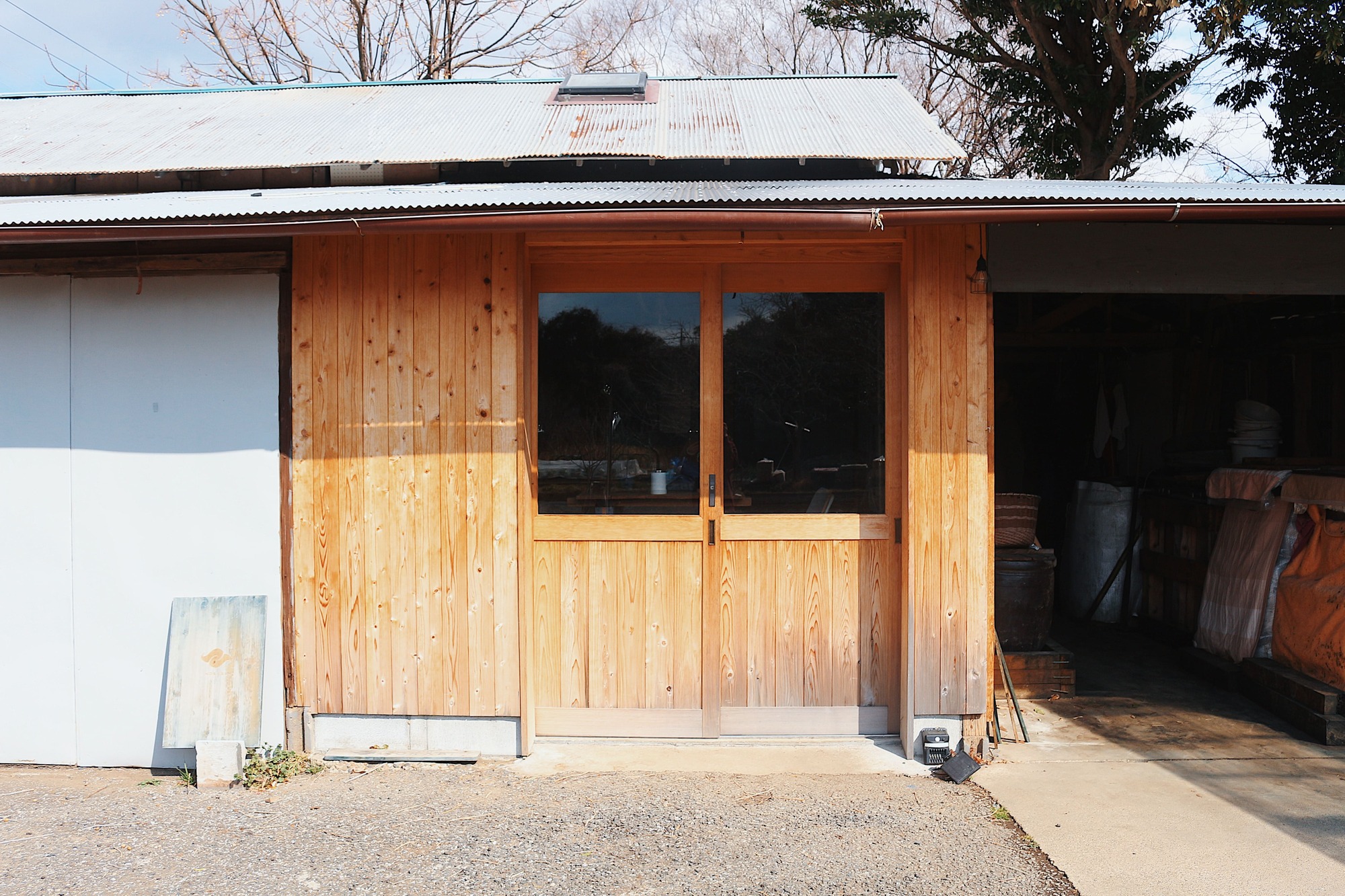
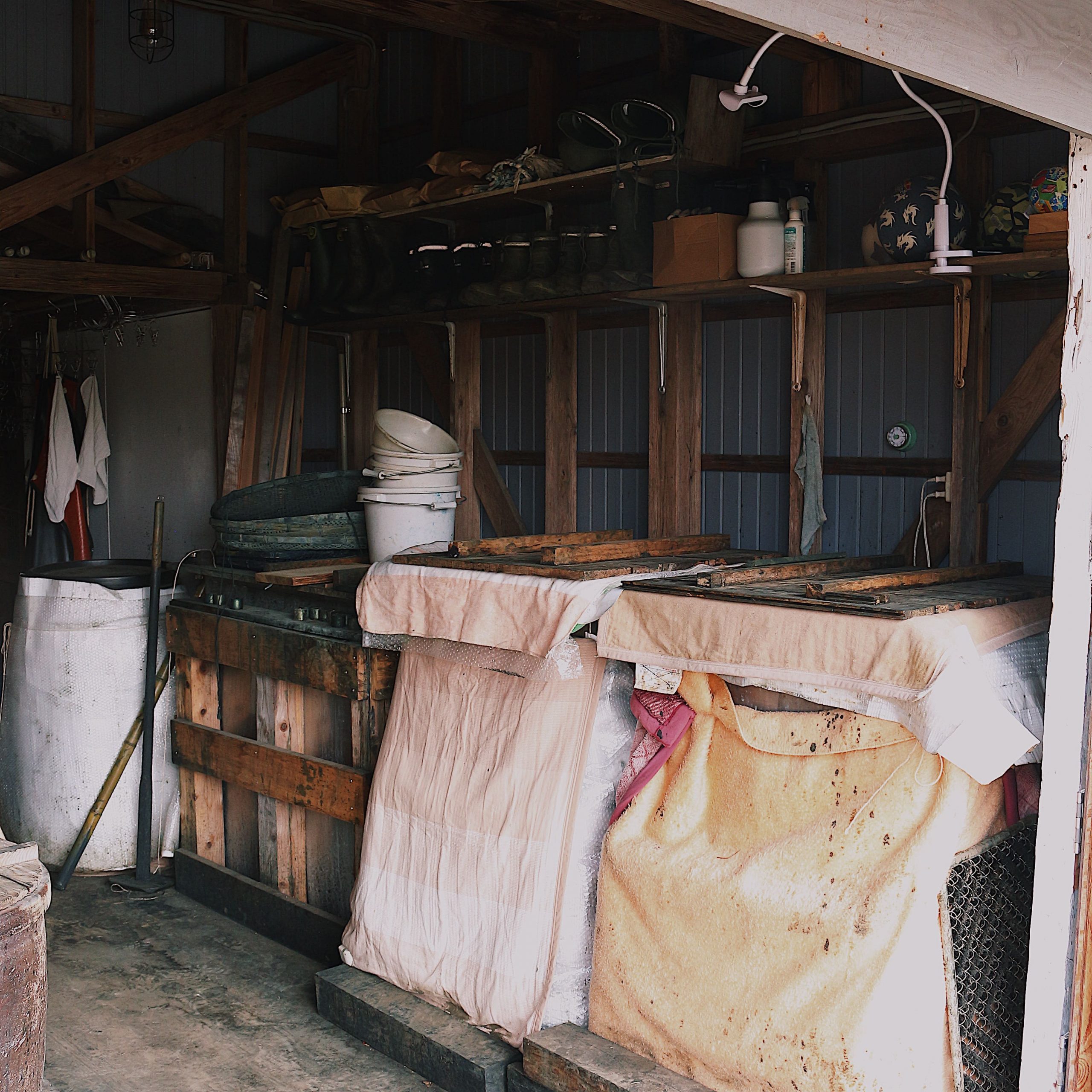
── 日本人として藍染に取り組む意味について、どのように感じていますか?
藍染は日本の伝統文化なので、日本語でなければ伝わらないことがある。海外とのつながりが深まる今だからこそ、日本人が藍染を担っていくことには意味があると思っています。
私にできることは、大海原のほんの小さな1滴みたいなもの。でも、それが波紋のように大きく広がっていってくれたらいいなと。環境問題は考えすぎると規模が大きすぎて無力感がすごい。だからこそ原点に立ち返って、自分にできること、持っている知識や興味を活かしたいと思ったんです。
── 実際に藍染の世界に入ってみて、どんなことが大変に感じますか?
もちろん大変なことはたくさんあるんですが‥‥サッカー選手になるまでに経験した厳しいトレーニングや、プレッシャー、競争、精神的な負荷といった日々と比べると、今はそんなに大変だとは感じないです(笑)。選手時代はメンタル、フィジカル共に毎日トレーニングしていたので、日々の作業を続けることには抵抗がありません。むしろ競争がない分、いまのほうが穏やかに過ごせている感じです。
── As a Japanese artist, what does working with indigo mean to you?
Indigo dyeing is part of Japan’s cultural heritage, and there are aspects of it that really can’t be communicated outside the Japanese language. Now that I have more opportunities to connect with people internationally, I feel even more strongly that it’s important for Japanese people to carry this tradition forward.
I know my work is just a small drop in a vast ocean—but I hope it can ripple outward. Thinking about environmental issues can sometimes feel overwhelming, like your efforts are too small to matter. But for me, it was about returning to the basics: doing what I can with the skills and passions I already have.
── What have been some of the challenges in this work?
Of course, there are hard parts. But honestly, after going through the intense physical training, pressure, and competition of being an athlete, this doesn’t feel that hard by comparison! I trained both mentally and physically every day, so I’m used to keeping up a steady routine. The absence of competition has actually made life more peaceful.
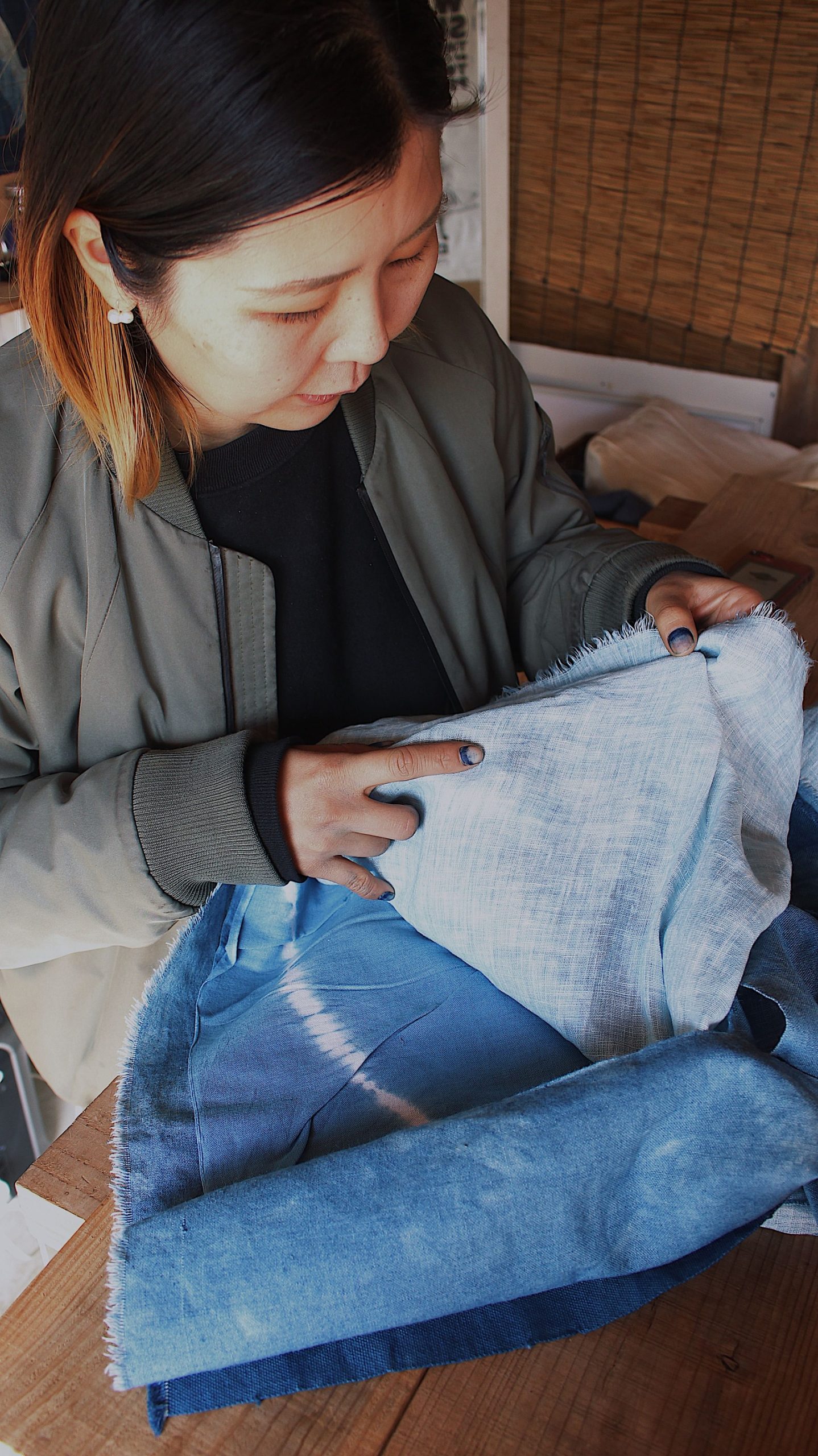
──今後は“すくも”作りへの取り組みも考えているとか。
(すくも:藍の葉を乾燥させて堆肥化したもの。藍染の染料となる)
はい、何年もかけて乾燥葉を集めているところです。今はすくもの作り方を学んでいる最中で、これから少しずつ自分で作ろうと考えています。
春に藍を植えて、夏と秋にそれぞれ一度ずつ収穫し、乾燥させた後に葉だけを使って3〜4ヶ月かけてコンポストにします。そこに水だけを加え発酵させます。さらに、広葉樹の灰にお湯を注いで沈殿させ、ミネラル分を含んだ上澄み液をすくもと混ぜて温め、二重発酵させるという工程があります。灰は、薪ストーブを使っている方々や、暖炉のお店、里山の活動団体などから分けていただいていて、お礼に藍染の作品をお渡しすることもあります。
すくも作りは結構大変で、染めと並行して行うのはなかなか難しいんですよね。無農薬、無化学肥料不耕起栽培で進めていきたいと考えています。
── We heard you’re also learning to make “sukumo.”
(Sukumo: Dried and composted indigo leaves, used as the base material for traditional indigo dye.)
Yes—I’m in the process of collecting dried indigo leaves and learning how to make sukumo, which is the composted base used in traditional indigo dyeing. It’s a long process: you plant in spring, harvest twice in summer and fall, dry the leaves, and then compost them over three to four months with just water. Later, you mix that with a mineral-rich lye made by soaking hardwood ash in hot water—this starts a secondary fermentation.
I source ash from local wood-burning stove users, fireplace shops, and satoyama (rural sustainability) groups, and sometimes I offer indigo-dyed items in return. It’s tough to manage this process while continuing my dye work, but I’d like to keep it pesticide-free, chemical-free, and no-till.
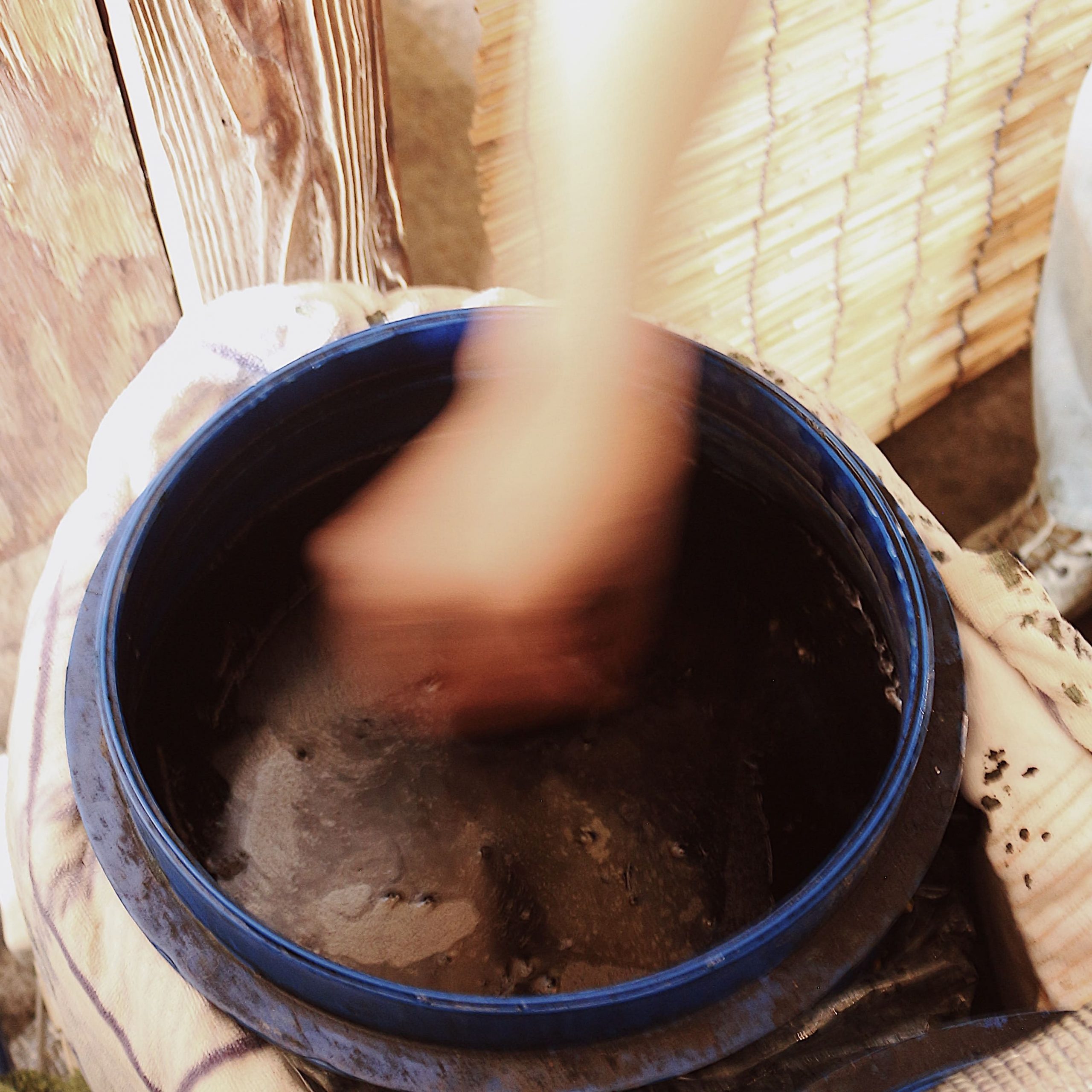
──eit swimの藍染シリーズはこれが2シーズン目となりますが、私たちもその魅力にのめり込んでいます。視覚的な美しさ、色の普遍性はもちろんですけど、ファッション性も高いですよね。
私も藍染に惹かれたのは、この青色。青は世界共通で誰もが身にまといやすい色ですよね。特別青が好きだったわけではないんですが、気づけば手元には青い服が多くて。自然と惹かれていたのかもしれません。
──今回eit swimのために制作していただいた2柄について教えてください。私たちからは、縄文土器っぽさをイメージした繊細な「ライン」と、薄めの「マーブル」というざっくりとしたオーダーをさせてもらいました。
「ライン」は正藍染の絞り染め。もともとペンアートが好きで子供の頃から絵を描いていて、細かい線だけで表現したり、空間を活かしたりするのが好きなんです。その感覚を絞りで表現しました。絞りは手縫いが主流ですが、今回は「紐」で縛っています。実は縫うより難しい部分もあります。
「マーブル」は、正藍染の特徴である淡い色合いを活かして仕上げました。本藍だと一度で濃く染まってしまうんですが、正藍は発酵の仕方が違い、淡い色も出しやすいんです。薄く、もやもやとした表情を出したくて、何度も何度も重ねて染めました。
── This is our second season working with indigo dye at eit swim, and we’ve grown completely hooked on its beauty. The visual beauty and timeless quality of indigo are undeniable, but your work also has such a strong fashion appeal.
I think that’s what drew me in as well—this specific shade of blue. It’s a universally wearable color. I never considered myself a “blue” person, but when I looked at my wardrobe, I realized how many indigo pieces I had. Maybe I’ve always been drawn to it without even noticing.
── Can you tell us about the two prints you created for eit swim? We gave you a rather loose brief—one was a delicate “line” pattern inspired by Jomon pottery, and the other, a light “marble” design.
The Line pattern is a shibori design using shō-ai (natural fermentation indigo). I’ve always loved pen drawing and fine-line work, and I brought that sensibility into this piece. Usually shibori is sewn by hand, but for this one I used string to bind it instead, which is actually harder in some ways.
The Marble pattern also uses shō-ai and takes advantage of its subtle coloring. Unlike chemically reduced indigo, which produces deep color quickly, fermented indigo allows for layering and nuance. I dyed it over and over to create those soft, misty textures.
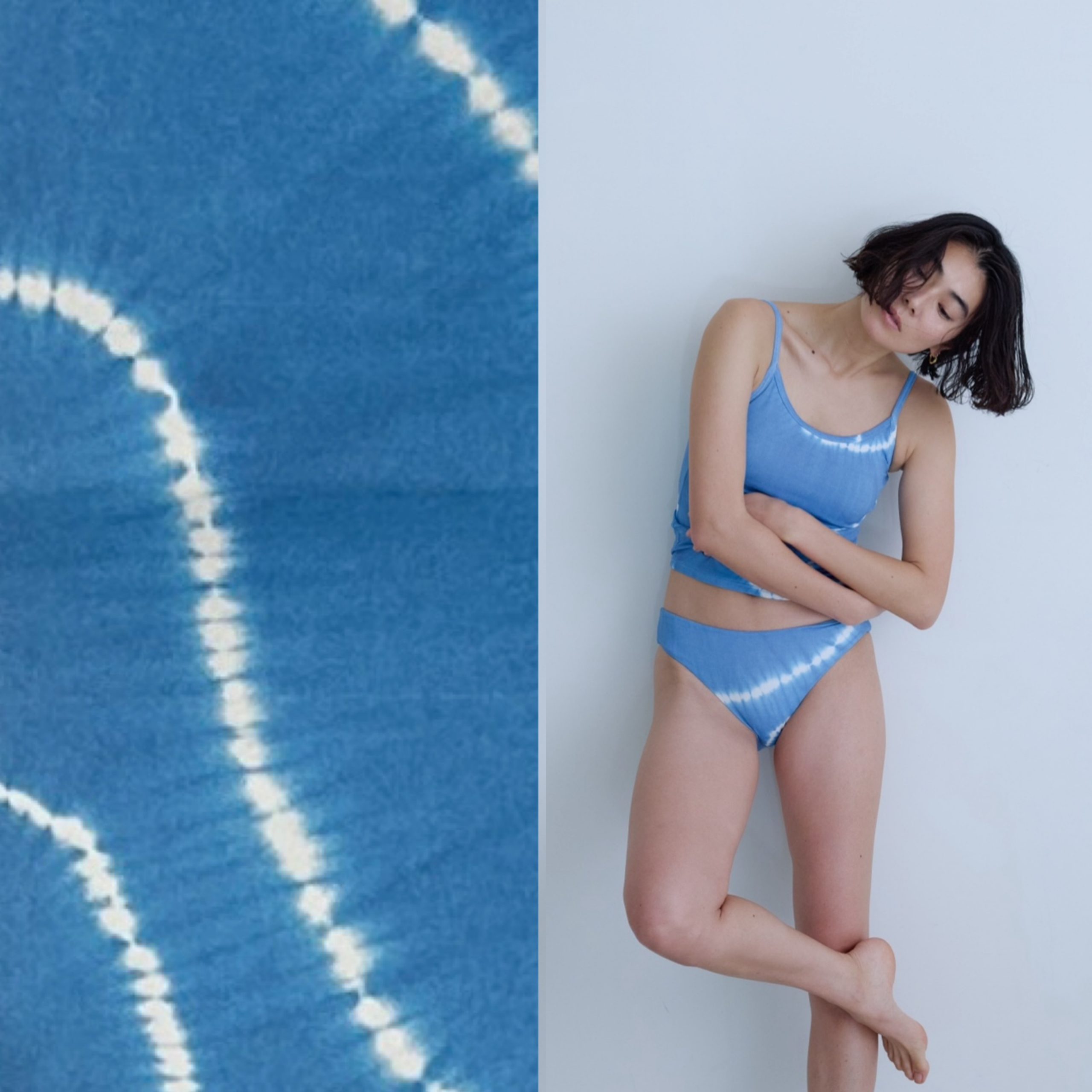

── 今後の展望について教えてください。
もともと自分のブランドを立ち上げることを目標に活動を始めたので、〈NORABI〉としての世界観を少しずつカタチにしていきたいと考えています。そして染めだけでなく、すくも作りなど、より “循環する”ものづくりを続けていけたらと思っています。
── What’s your vision going forward?
When I first started, my goal was to eventually launch my own brand—and that’s what NORABI is becoming. I want to keep building on that vision, and to keep pursuing a style of making that is truly regenerative—from the soil to the fabric.

